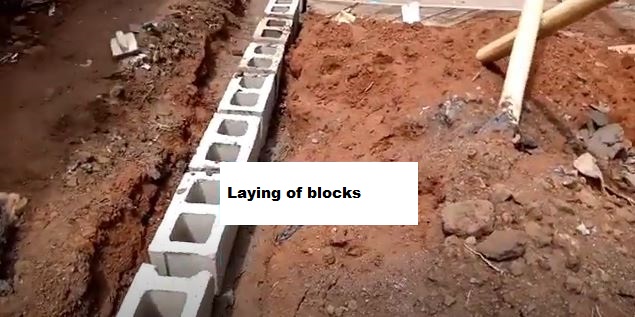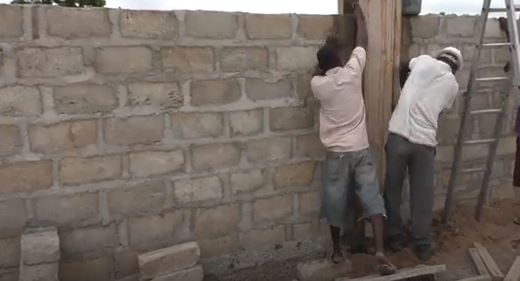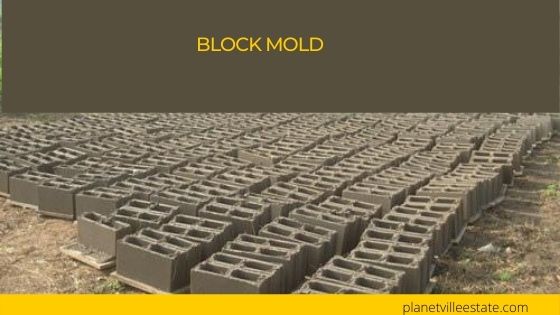Are you planning to fence a landed property? Do you want to know how to calculate the number of blocks for the fence? Or do you want to know how many blocks it will take to fence a land size of 60 by 120?
In this article, I have put together (calculated) the number of blocks it will take to fence a plot of land (60 by 120) to the height of 12 feet using 6 inches blocks.
6 inches and 9 inches blocks are frequently used blocks for fencing plots of land, even though there are other types of blocks, such as 5 inches and 4 inches blocks.
However, I have previously calculated the number of blocks it will take to fence a plot of land using 9 inches blocks on one of the articles I wrote on “cost of fencing 2 plots of land” you may refer to it.
The land size of 60 by 120 which is a plot of land in some places in Nigeria (like Lagos state) simply means that the two breaths are 60ft each and the two lengths are 120ft each.
Read: Buyers; what to know before buying a plot land in Lagos Nigeria
How to calculate the number of blocks needed to fence the land size of 60 by 120
Generally, when fencing a plot of land, there is part reserve for the entrance which is where to fix the gate. So we are going to minus that part from the land because we don’t need to dig the ground of that portion in other to lay blocks.
How to calculate the total area to be fenced
To calculate the land size of 60 by 120 which is, 60ft + 60ft + 120ft + 120ft = 360ft converting it to meter will give us 109.728m approximate to 110m.
This implies that the total area of the land is 110m. Since we are calculating blocks for fencing, also we have initially stated that we will minus the part where we will fix the gate on the fence. The space for it is 12ft.
Thus, converting 12ft to the meter will result in 3.6576m, approximately 4m. So the total area to be fenced will be 110m – 4m = 106m.
Now that we have gotten the total area to be fenced, the next is to calculate the number of blocks and pillars (columns) required to fence the area (106m).
Check out >>> our genuine investable plots of land for sale in different locations in Lagos Nigeria
How to calculate the number of blocks to be used on the fence wall
Reminder:
The total area to be fenced is 106m
The length of any given block is always 450mm or 0.45m which is equivalent to 18inches.
The width of any given block varies, the commonly used ones are 6inches (150mm) blocks or 9inches (225mm) blocks.
Having declared that, we will first calculate the number of blocks needed to lay first level or coaches.

So to calculate the number of blocks that will be used for laying the first coaches on 106m of land is by dividing “the total area to be fenced (106m)“ by “the length of a block (0.45m)”. Which is 106m / 0.45m = 236block.
From the above result, we need about 236 blocks to lay the first coaches on the ground. Nonetheless, we will need to calculate the number of blocks that will be required to fence the wall to a height of 12ft.
Please note that two-level/coaches will be buried on the ground and 10 coaches will be on the fence wall.
Now, we have to multiply 236 by 12: (236 * 12 = 2832 blocks). This simply means we need about 2,832 blocks to level the wall of the fence to a height of 12ft.
Next is to calculate the number of pillars (columns) that will be needed on the fence
Advice: always make provision of extra blocks because you may likely encounter some damages or broken ones.
Check out >>> Architect cost for house plan
How to calculate the number of pillars (columns) to use on the fence
We will take the distance between one pillar to another to be 3m. So in other to get the total number of pillars or columns needed for the entire fence wall, we will have to divide the total length of 106m by the distance of each pillar or column 3m.
Therefore, 106m / 3m = 35 pillars (columns). This implies that to fence the total length of 106m of a plot of land it will take 35 pillars (columns).
The project and the nature of the land will determine if you were to use blocks for pillars or iron rods (reinforcement).
Below is the calculation of the number of blocks that will be required to construct 35 pillars (columns). However, the two pillars for the gate will use an iron rod (reinforcement).
How to calculate the number of blocks required for 35 pillars (columns)
Please note: using blocks for the pillars (columns) instead of an iron rod (reinforcement) is only recommended if the land is dry land. But, if it were to be a swampy area or water-logged area it is advisable to use reinforcement.
To get the number of blocks for one pillar; it will be 1 block multiplied by the number of coaches, in this case, is 12 coaches. Thus, 1 * 12 = 12 blocks for one pillar.
So to get the number of blocks that will be used on 35 pillars (columns), we multiply 12 blocks by 35. Therefore, 12 * 35 = 420 blocks for the 35 pillars.
Conclusion:
From the above calculations, it is obvious we will need 2,832 blocks for the fencing plus 420 blocks for the pillars. Which in total is 2,832 + 420 = 3,252 blocks.
This means that it will take 3,252 blocks to fence a dry land with a size of 60 by 120 to a height of 12ft using 6 inches block.

Determining the cost
If you want to know the cost, the bill of quantity for any of your projects before the commencement of it. We are here to work with you.
We have qualified and experienced Quantity surveyors (QS) ready to provide you with the workaround cost of your project. All you need is to get in touch with us.
Check out >>> cheap land for sale in Epe area of Lagos
Why you need the service of a QS for costing your project
Knowing the cost of a project before commencing on it is so important. It helps the owner to plan or budget financially on how to go about it before starting the project.
It also helps him to know the cost of the project. Know the time frame, how and when to start, who to use for the project, and the best time to start.
At the same, it helps to avert project abandonment which is becoming a norm here in Nigeria. That is why I strongly advise anyone who intends to start any building projects to quickly engage the service of the quantity surveyor (QS) for the bill of quantities.
Honestly, that is the best step to follow before starting any building project, especially a huge project. Most times people tend to shy away from their services because they don’t want to spend money.
The question is, is it better to start a project and get it abandoned or end it halfway than to pay a QS to get the cost and plan it properly to get it done within your time frame and budget?
The answer is yours. Also, if you need the services of an experienced Architect and Certified Engineer for your building construction Project. Get in touch with us today.
Check out >>> how to build a house on a small budget
Causes of poor quality blocks which affect the quality of the building project
Below are the possible things that can affect the quality of blocks, if you were to mold the blocks on site.

Bad mixing ratio and re-packaging of cement:
Sometimes when one engages unskilled laborers on-site for block mold, they tend to mix more sand to the cement than the recommended standard in other to produce more blocks. The fact is that by such an act, they are doing more harm to the project than good.
Also, buying a re-packaged bag of cement is another practice that causes poor quality blocks production on site. Most times some deceitful sellers tend to remove cement from bags, re-package it and sell it as full bags.
The implication of this act is that when mixing cement on-site by using the standard ratio, the quality of blocks that will be produced is going to be low quality.
Check out >>> Affordable and investable land for sale in Ikorodu Lagos
Sand quality:
Most times people tend to use sand from the roadside, gutters, etc. to mold blocks, which is not recommended.
The best and recommended sand for molding blocks is sharp sand. But note, it shouldn’t be too sharp because if it does, it will not be good for quality block production.
Also, the sharp sand is supposed to be the type collected from the beach or floating water, at the same time free from stones or any other type of unwanted material.
Using low quality or expired cement:
When you purchase cement that has expired or been kept for so long by the seller is going to affect the quality of blocks.
On another hand, if you purchase cement and keep it for future use, that will also affect the quality of the blocks because those cement is going to lack some qualities needed to make blocks.
Rainfall
Rain is another factor that can affect the quality of blocks mold on site. That is why after molding blocks on-site, make sure you use a nylon sheet to cover the blocks during rainfall because the newly mold blocks are very soft any little rain can wash them off.
Also, ensure that there is no erosion passing under it because that can affect the blocks as well.
Tips to note when buying blocks from a block seller or industry
- Purchasing blocks from a seller near your construction site is cheaper than purchasing from a seller that is far from your site. But always make sure the blocks are in good quality and condition before purchase.
- Allowing the block seller to water the blocks for some days before buying is the best practice when purchasing some blocks from the factory. Blocks that are not very dried are always fragile so they tend to break easily thereby causing more cost to the buyer.
- Purchasing blocks that are kept for a long time by the seller are better and are always the best quality blocks.
- Making payment upfront when negotiating to buy blocks from the seller is not a good method as such is not advisable. The reason is that the seller can produce blocks that are below standard. Which in turn affects your building project.
- Blocks that are molded with sharp sand are always costlier than the block’s mold with sand from the roadside. So make sure you purchase the right blocks. Don’t make the mistake of purchasing the wrong block because the other block is cheaper.
Also don’t allow the seller to trick you by selling the block’s mold with roadside sand at the same price as the one mold with sharp sand. - Using your hand to check the block quality by grabbing the edge with your index fingers can also help you to detect if the blocks are of good quality or not. Low-quality blocks easily break once you touch them with your fingers. But good quality blocks remain strong as you touch them.
Check out >>> Land for sale in Owerri Imo state
Frequently asked questions
Can I use 6 inches blocks to build my house instead of 9 inches?
The choice of blocks to use is determined by so many factors, most people prefer to use blocks with less width to reduce their expenses on concrete and even reduce their cost of blocks since 6 inches blocks are less costly than 9 inches counterparts.
The reduction in building costs is usually the main reason for this. Other reasons include the need for more room, as slimmer blocks can add some millimeters to your room sizes, additional reasons might include weight reduction.
There are so many situations where you need to be very careful about the block type you use. There are places in a building where the width of your columns matters so much. In those corners of the house, the columns bear a substantial load and thus need to be sturdier.
I will advise here, for you to ensure that a qualified professional is engaged in this process, he is going to look at the building plan and the land in question before he can advise on the type of blocks to be used.
Things like the block type to use are usually spelled out in the structural drawings of a house plan.
Nevertheless, it’s okay in a bungalow. Just ensure that the piping of waste and electricity is well considered.
Check out >>> 4 bedroom duplex for sale in Yaba Lagos
How much is 6 inches block in Nigeria 2020?
The cost of 6 inches block in Nigeria varies from place to place or state to state. However, the price of the block ranges from ₦170 to ₦250 per block.
How many 6 inches blocks can be made from a bag of cement?
The standard recommended number is 25 blocks per bag, but most people mold 30 to 40 blocks from a bag of cement.
How many blocks (9 inches hollow) can a bag of cement produce?
It actually depends on how many blocks you want to make from a bag of cement and what you will use the block for, I will recommend targeting 18 to 23 blocks per bag.
How many blocks can fence 50 By 100?
This question depends on the height of the fence wall. However, if you are to fence it to 12ft height also fix a gate with a distance of 12ft on the fence, then the number of blocks that it is likely to take is 2,320 blocks or more excluding the pillars.
How many blocks can fence a plot of land in Nigeria?
It takes 2,832 blocks or more to fence a dry plot of land excluding the part made for the gate.
What is 9-inch block dimensions in mm?
The 9-inch block is equal to 225mm.
How many blocks can a bag of cement lay?
It depends: (1) the type of block you want to produce. (2) It also depends on what you want and what you want to use the block for.
For instant, if you are to mold 6 inches blocks for building a house the recommended standard is 25 blocks per bag. For 9 inches block the recommended number of blocks per bag is between 18 to 23 blocks.
I hope you find this article useful. If you have any questions, suggestions, addition, correction, etc. Please feel free to comment on the comment box below
You may also Check >>>
Land for sale in Benin City
Cheap land for sale in Ikorodu
The requirement for building plan approval
How to invest smartly in real estate properties in Lagos and make a huge profit
What to know before buying land in Nigeria, don’t be a victim
How to get your building plan permit in Lagos
Copyright Notice: This post belongs to https://www.planetvilleestate.com/ kindly click here to visit our blog page for more amazing related content. Also, ensure you don’t violate our privacy policy while using our site. Thanks














Dr Gilbert Enechi
16 Mar 2022Thank you very much for the whole calculation.
However, I wish to make the following observations for the benefit of the readers:
1) While calculating the total no of blocks required to fence a plot, you did not take into consideration the following deductions:
a) The total space (both heightwise and lengthwise) occupied by binding mortar. ( ie: the mortar thickness used to bind 2 adjacent blocks). Although it appears small for 2 blocks but could be huge when you have to bind about 3000 blocks
b) The total space occupied by the pillars (this should be deducted as well)
2) Also you kept on talking of the “Area” where I believe you meant the “length”! since Area = {Length or width} x-height. Your calculation applied linear or one dimension (1D) method and is not bad if you effected the necessary deduction as I earlier pointed out. However, it is also possible to work directly with the “area” or 2D method, although the calculation becomes more complex but more accurate. And this is the case where the use of the word “area” is rightly implicated.
c) Finally, I may also like you to calculate the quantity of sand-cement mixture required to bind a given fence dimension for a given plot size. I believe This is where the application of the 3D or volumetric method is indicated, although with more complexity! With this calculation, it is possible to quantify the number of cement bags and sand trips required to bind a fence.
Generally, your guide is as simple as possible as to carry everybody along without complex arithmetic. Well done for the estimation guide!
Dr Enechi Gilbert